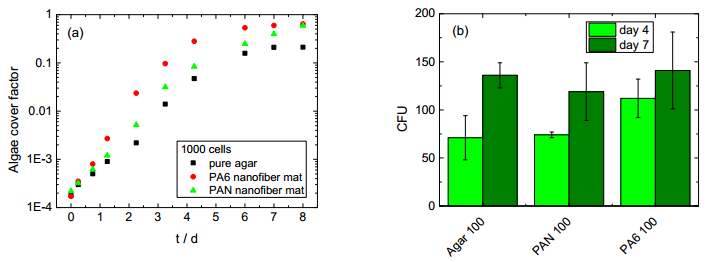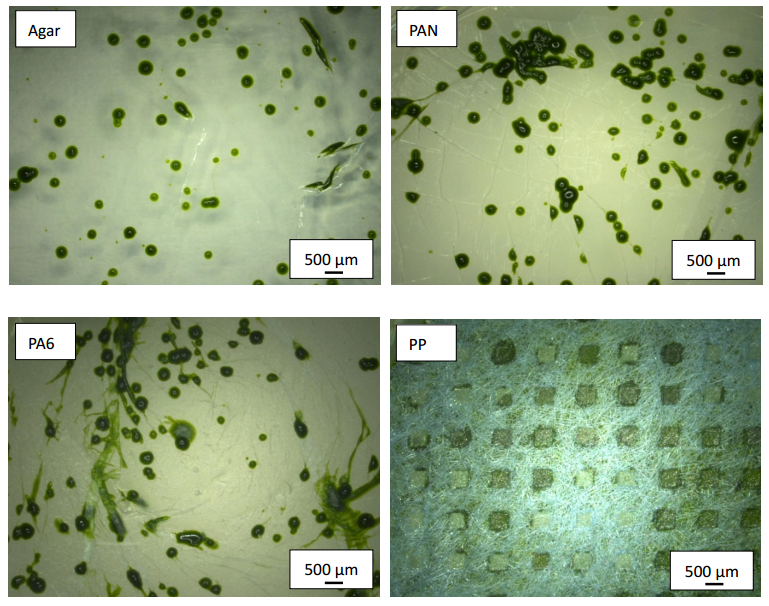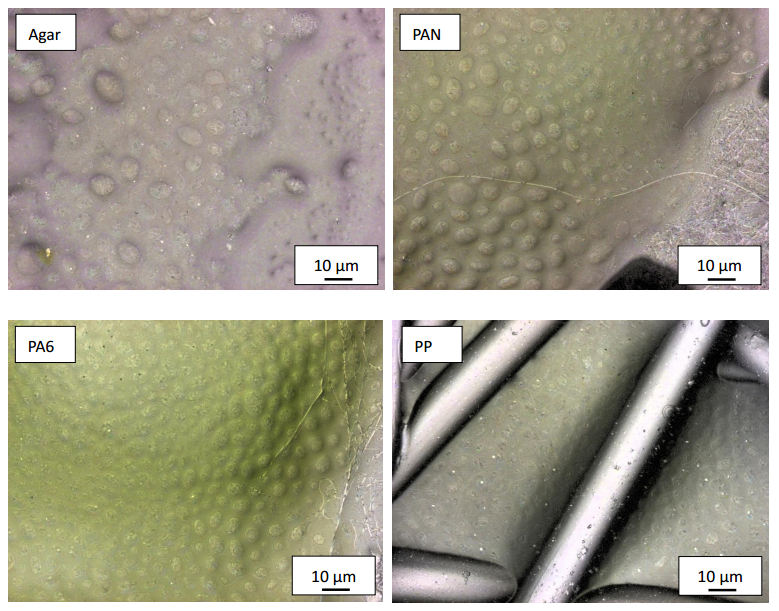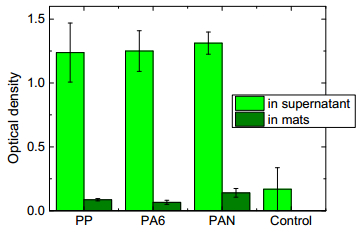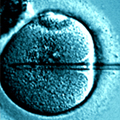1. Introduction
Water-insoluble nanofiber mats can be created by electrospinning of polymers like PA6 (polyamide) or PAN (polyacrylonitrile), either in pure form or as a blend with other materials [1,2]. Nanofiber mats can be used in a variety of applications, such as gas filters [3], water filters [4] or biological filters [5,6,7], but also as scaffolds for medical purposes [8,9].
Due to their high porosity and spatial interconnectivity, nano-and microfiber based materials support the diffusion of nutrients in culture media and the cultured cell's motility [10,11,12]. This is one reason for diverse research groups to use textile materials, especially nanofiber mats, as substrates for growth of e.g., mouse fibroblasts [12], dorsal root ganglia explants [13] and the immobilization of peptides [14]. Only few examples exist in the literature where viable microalgae (Chlorella vulgaris, Chlamydomonas reinhardtii) have been immobilized in nanofiber mats. These mats were tested in wastewater treatment [15,16,17]. In these studies, chitosan, chitosan/TiO2/Ag hybrid and polysulfone were used as polymers for electrospinning. Other studies investigated the co-spinning of chitosan or polyethylene oxide (PEO) with Spirulina biomass. These nanofibers were examined for a possible use in tissue engineering [18,19].
On the other hand, nanofiber mats spun from several materials were investigated with respect to their filter properties. PAN nanofiber mats were treated with Ag/amino-terminated hyperbranched polymer [20] or blended with silver nanoparticles [21] to increase the antimicrobial properties of such filter materials, but also used in pure form as air filters [22]. PP is a typical filter material for diverse applications, including biotechnology and medicine, due to its stability against many chemical solvents, bases and acids [23,24,25]. On the other hand, it is often used in the area of scaffold engineering [26]. PA6 can be used for fuel filtration [27], filtering bacteria from fluids such as blood plasma or water [28] or general microfiltration applications [29].
For cell growth as well as filtering living cells, it is generally necessary to avoid poisonous materials. Instead, relatively inert materials should be used or, especially for cell growth, materials can even be doped with ingredients which promote cell growth. This is why PAN is of special interest in this study—it can be spun from non-poisonous DMSO (dimethyl sulfoxide), avoiding possible undesired inclusion of poisonous ingredients in the final nanofiber mats.
In our study, we investigated the growth and adhesion of the microalga Chlamydomonas reinhardtii on different nano-and microfiber based materials (PA6, PAN, PP) and compared these properties with growth and adhesion in common multi-well plates. In this first study, we did not aim at tailoring these materials for ideal cell growth, but wanted to examine cell growth on these pure polymer materials as a starting point.
C. reinhardtii is widely existent in fresh water worldwide and thus often serves as a model organism for fundamental biological questions. This alga can grow photoautotrophically and can produce hydrogen [30], biofuels or other compounds [31]. Thus, it is of great biotechnological research interest.
2. Materials and Methods
2.1. Nanofiber mats
The needleless nanospinning machine "Nanospider Lab" (Elmarco, Liberec/Czech Republic) was used to produce electrospun nanofiber mats with the following spinning parameters: voltage 80 kV, carriage speed 130–150 mm/s, nozzle diameter 0.6–0.9 mm, electrode-substrate distance 160 mm, substrate speed 0–50 mm/min, relative humidity in the chamber 35–38%, temperature 22 ℃.
For the first spinning solution, 14.8 wt% PA6 grains were dissolved in acetic acid (for synthesis, 99–100%, AppliChem, Darmstadt, Germany)/formic acid (technical grade, 99%) 2/1 (v/v) by stirring for 5 hours at 80 ℃. The second spinning solution was prepared by dissolving 15 wt% PAN in dimethyl sulfoxide (DMSO, min 99.9%, purchased from S3 Chemicals, Bad Oeynhausen, Germany) by stirring for 2 hours at room temperature. As a third nonwoven, a polypropylene (PP) fiber mat (purchased from Elmarco s.r.o., Liberec, Czech Republic) was chosen which is normally used as a substrate for electrospinning.
2.2. Investigations
Images of the nanofiber mats were taken using a confocal laser scanning microscope (CLSM) VK-9000 with a nominal magnification of 2000×. Optical microscopy was performed with a digital microscope VHX-600D, using nominal magnifications of 20–200×. Both microscopes are from Keyence, Neu-Isenburg, Germany.
For the evaluation of the cover factor of the algae, i.e. the percentage of a microscopic image which was covered by algae, the software ImageJ 1.51j8 (from National Institutes of Health, Bethesda (MD), USA) was used on 5 images per sample.
2.3. Growth tests
The Chlamydomonas reinhardtii strain CC-124 was kindly provided by Prof. Dr. Olaf Kruse, Bielefeld University. Algae were cultured in TAP (tris-acetate-phosphate) medium [32]. Algae cultures in their exponential growth phase were used for the respective experiments.
From the three different fiber mats, areas of 10 mm × 10 mm were cut and placed on agar dishes (6 cm, SPL Life Sciences; TAP agar-TAP medium with agar; Agar-Agar Kobe Ⅰ, for microbiology, Roth, Karlsruhe, Germany). As a reference, TAP agar dishes without any textile fabric were used.
Roughly, 100 and 1000 alga cells per dish were used to start colonization, respectively. The plates were illuminated by warm-white LED lights (Nichia, light intensity 2.1 klx at the sample surface) during the whole experiment. Tests were performed in quadruplicates. Microscopic images of all samples were taken directly after preparation and at least once per day. Colony forming units (CFU) were counted 4 days and 7 days after colonization start.
2.4. Adhesion tests
From the three different fiber mats, areas of 15 mm × 15 mm were cut and placed in a 24 well plate (SPL Life Sciences, South Korea). As a reference, empty well plates without any textile fabric were used. 1.25 ml alga pre-culture in TAP medium and 1 ml fresh TAP medium were added to each well. 6 wells per fiber mat/reference were prepared in this way. The plates were illuminated by LED lights (as above) during the whole experiment.
24 hours later, the fluid was pipetted from all wells. All fabrics and the reference wells were rinsed three times with medium and subsequently supplied with 1 ml fresh TAP medium.
4 days after rinsing the fiber mats and the reference wells, the optical density of the supernatant liquid was measured using an ultraviolet/visible (UV/Vis) spectrophotometer Genesys 10S (Thermo Scientific, Waltham, MA, USA) at a wavelength of 750 nm. The residual algae in the fiber mats were investigated by putting them into 1 ml of distilled water and separating them from the nonwovens, using an ultrasonic device (UP200Ht, hielscher, Teltow, Germany). Afterwards the textile fabrics were removed, and the absorbance of the supernatants was again measured as described.
3. Results
Microscopic images of the nanofiber mats as well as the PP nonwoven are depicted in Figure 1 (identical magnifications). The differences between the fiber diameters are clearly visible, varying from approx. 500–800 nm for the nanofiber mats to more than 10 µm for the PP nonwoven.
The three fleece materials were placed on agar and algae suspensions (approximately 100 or 1000 cells per dish, respectively) and subsequently spread on the fabrics. Agar without a textile layer served as a reference.
Figure 2a shows the algae cover factors (fraction of the dish surface area covered by cells) of the samples started with 1000 algae/plate, measured by microscopic images taken with a nominal magnification of 200×. The PP nonwoven could not be examined this way due to its thickness and the problem that algae in deeper layers were hard to find, especially when hidden behind higher fibers. During the first four days, an exponential growth was visible for the pure agar plates as well as for both nanofiber mats. From day 6, colony growth was reduced, as expected when approaching a cover factor of 1 (i.e., 100% of the image area covered by algae). It should be mentioned, however, that the height of the colonies was not taken into account since it could not be measured reliably by a digital optical microscope. The algae cover factor was thus not linearly proportional to the number of algae on the samples, but gave an estimate of this value.
The number of colony forming units was investigated on pure agar plates as well as both nanofiber mats, starting from 100 algae per plate (Figure 2b). Again, counting colonies was impossible on the PP nonwoven. Interestingly, the number of CFUs increased over time which can be explained by the fact that the C. reinhardtii CC-124 used for the study carries flagella. Therefore the cells were able to swim actively inside possible grooves on the agar plate or creases of the fiber mats to start new CFUs. These originally undesired grooves were visible on the agar plates in microscopic images and can easily be seen in the images of PAN and PA6 in Figure 3. All nanofiber mats under investigation tended to shrink slightly during the first contact with water or humid surfaces, resulting in a crinkling effect during placing them on the agar substrates. These "channels" look often light-green due to a few algae swimming through them or darker green due to larger colonies built inside them.
Interestingly, the number of colonies on the different substrates was not significantly different. Taken together, the data show that the polymers were not toxic to C. reinhardtii.
Figure 3 depicts images of the surfaces colonized by algae, starting with roughly 100 algae/dish, 7 days after sample preparation. The highest colony density could be found "inside" deeper layers of the PP nonwoven (lower right panel) which made algae density evaluation difficult since most algae were not visible from the surface. On both nanofiber mats it was observed that the creases in the materials served as fluid media tunnels, facilitating algae spreading over the surface.
Similar effects were visible in the few erroneous cuts on the agar surface. PA6 contained more creases compared to the PAN nonwoven and the pure agar surface which could explain the fact that coverage of the plate by algae was fastest on the PA6 fabric (Figure 2a).
The colonies were also examined by CLSM, as shown in Figure 4. While the visible algae had similar morphology in all images, colonies on both nanofiber mats appeared somewhat darker, indicating that they tended to form stacks in contrast to the colonies grown on pure agar (upper left panel). In the PP nonwoven (lower right panel), the colonies were visible only "through" the textile fabric. Together, these observations indicate that C. reinhardtii did not spread via the fibers but preferred to grow (and swim) inside the drops and fluid channels or cavities on the textile fabrics.
To support this hypothesis, further experiments were carried out to investigate the adhesion strength of the algae to the three fabrics in well plates. Cultivation of algae in wells without fabrics served as controls. After 24 hours, the supernatants were taken off; the wells were washed and cultivated for four more days. Optical densities of the residual supernatants and the washes obtained by ultrasonic-cleaning the mats were measured 4 days after rinsing the samples, as described above. As can be seen in Figure 5, the supernatant showed optical densities between 1 and 1.5 for all textile fabrics, without significant differences between them, indicating that the cells did hardly adhere to the mats. Only few cells were entangled in the fiber mats that could be released by the ultrasonic treatment.
Thinking about a possible application of such nanofiber mats as biotechnological filter materials, it should be mentioned that even after ultrasonic-cleaning, the nanofiber mats under investigation did not show any optical or mechanical damages. Handling the thin mats, however, must be improved for possible applications, e.g., by creating mats with a thicker outer border (which is possible, e.g., by integrating respective conductive areas on the substrate for the electrospinning process [33]). In this way, it should be possible to avoid undesired folding of the nanofiber mats during ultrasonic treatment and the challenging process of completely unfolding them again before re-using them.
4. Discussion and Conclusion
The investigations depicted here show that C. reinhardtii was able to grow on textile substrates (PP, PA6 and PAN) indicating that the polymers were not toxic to the organism. However, the cells did not adhere to the fibers. This finding is in contrast to former observations made by Keskin et al. [16] who found that Chlamydomonas reinhardtii was able to adhere to polysulfon (PSU) nanofiber mats. The fact that microalgae do hardly adhere to PA, PAN or PP could render electrospun nanofibers from these materials suitable as tailored filters for cell separation e.g., in biotechnological processes.
Algae growth and filter properties will be investigated in detail for nanofiber mats of different morphologies, varying especially the fiber diameters and the mat densities.
Acknowledgement
The authors would like to thank Prof. Dr. Olaf Kruse, Bielefeld University, for providing the algae for this investigation.
Conflict of Interest
All authors declare no conflicts of interest in this paper.










 DownLoad:
DownLoad: 